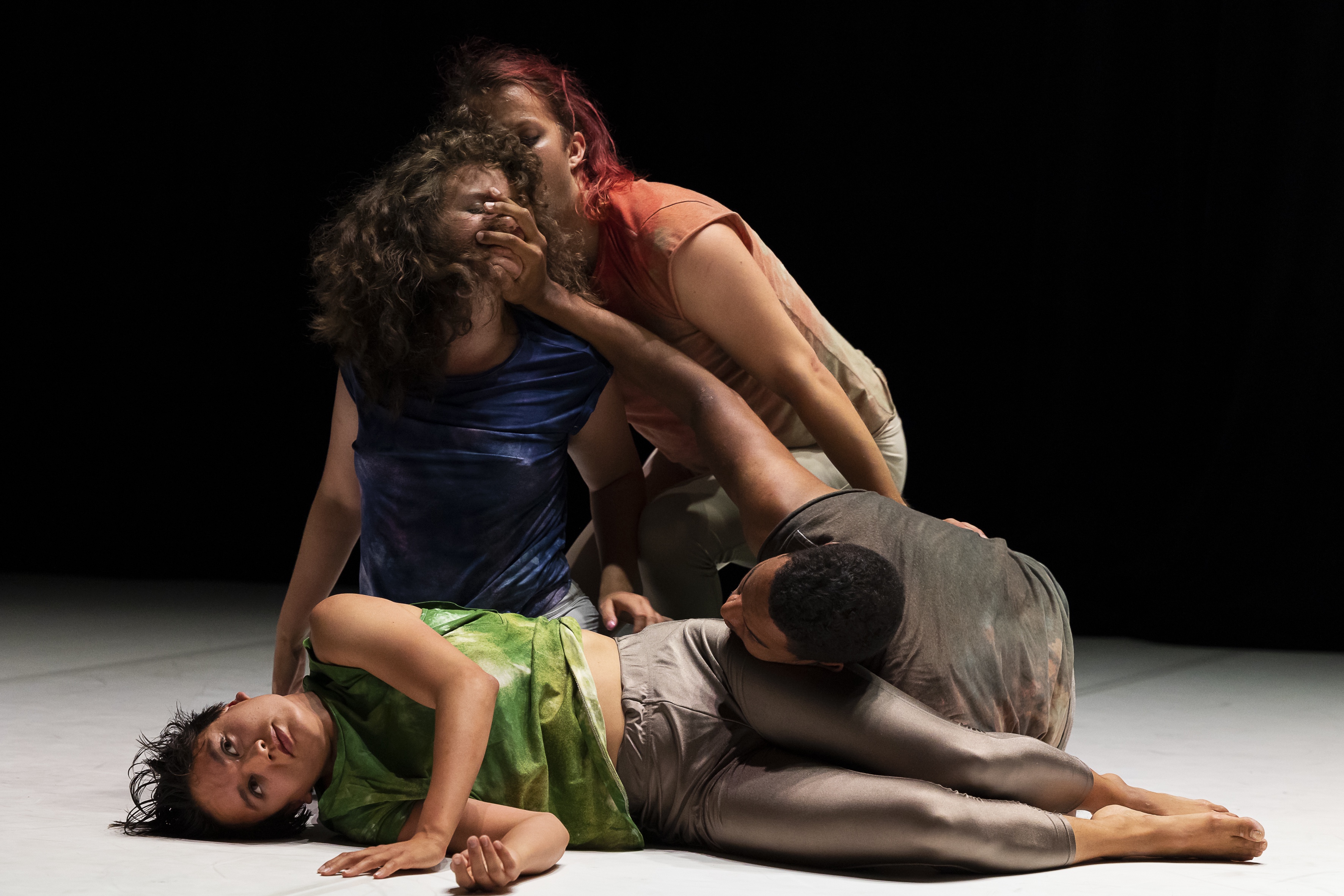Words by Katherine Adams.
Mesh, which premiered in Berlin at the Tanz im August festival, is a work modeled after forms of organic generation. The piece draws on principles one might find in contact improvisation to explore an intensely non-anthropomorphic autopoiesis within movement. Within the basic movement score of the work, one can discern Finnish choreographer Maija Hirvanen’s interest in root networks, such as fungal ‘mycorrhizal’ networks that connect flora underground. Yet one of the more stunning aspects of this piece is how it interweaves sequences redolent of primordial, pre-bodily instinct with distinctly sapient, communicative qualities of the body such as voice and song.
The work starts with jerking movements that course, as if unwillingly, through each of the four dancer’s limbs. Knees jolt toward the ceiling, seeming to burst with a critical mass of generative energy not yet sutured to any clear purpose or trajectory in the movement. In this preliminary stage, the dancer’s bodies are clearly individuated, but soon the organic force rippling through their quartet activates the nascent Mesh along a third plane of motion. Traversing the space between themselves, the dancers morph slowly into a melded body, imparting a heavy quality to the same weighted bodies whose joints we just saw lifted toward the ceiling.
We initially encounter these four bodies in a moment of dispersal–but now, their movements indicate that separation must be avoided at all costs. In pairs, the four push up against one another–their intensely close, nearly invasive gestures suggest fragmented forms of intimacy or aggression. Yet ultimately, these interactions are detached from any clear emotion. At one point we see a chin touched, as if affectionately, but this caress dissolves into a controlling twist of the head; another dancer’s embrace becomes a nearly acrobatic tumbling that progresses along and against the body of their partner–the other dancer appears one moment as a collaborator, and the next only as a structure. Whatever interpersonal semantics one might try to discern in these partnered micro-scenes quickly dissolves. Affect is labile and uncertain, subsumed under a collective drive toward growth.
Halfway through the work, after Mesh’s collective body moves through these stages of grafting, imbrication and branching-together, a dancer collapses. Until this moment, the work’s four performers embody the propagation of emergent life–restlessly grafting their limbs onto one another, their movements appear shaped by a latent force of spontaneous growth impelling each dancer’s tumbling body toward a common, shifting centre of gravity. Before this climactic fall, touch and skin-to-skin connections had appeared vital to the work’s movement language. Yet once sound and vocalisation supplant the function of contact, the composite bodies from Mesh’s opening sequences simply access another layer of organic feedback–growth, power and potency become possible across distances.

The midpoint lapse created by this newly immobile member fractures not only the group’s hybrid body but their very principle of motion. It is a rupture in the dramaturgy of this networked world, and for the work to move forward, voice must take the place of touch. Confronting the death or physical failure of their fourth member, the remaining three performers begin to sing. Here, after its biomorphic slippages between so many purely organic, quasi-primordial forms of motion, Mesh connects immediately back to a quasi-human impulse without shifting us out of the interwoven, coordinated world of ahuman growth. One could liken this brief poetic sketch to mourning or grieving, given the passage’s almost ceremonial character. After Mesh has purified our interior, human-centered perceptual archives of emotional references–ensuring that we no longer see Mesh’s partnered movements as overtures to desired others but as facets of a collective need–we are confronted again with a gestural clarity that might seem irreducibly human.
Significantly, this shift towards a motif of human ritual happens no longer through the frame of a life-force but on the pretext of bodily death. In the wake of this brief melancholy Mesh’s principle of coherence broadens. What before demanded contact can now take place through coordination. Limbs no longer need to be grafted onto one another, but cut through the air like scythes, in synchronisation. Still later, liquid port-de-bras of one dancer’s arms suggest a more cerebral control over the environment, a new principle of development. Whether or not it intended to leave the realm of fungal motion, what we see unfold is an exterioriaation of the principle of growth, the development of technique through and ultimately beyond the sphere of corporeality.
Nevertheless, Mesh does not leave us with a settled, developmental narrative of organic motion. Even if human remnants of motion and comportment seep through at its theatrical checkpoints, cyclicality remains key to the work’s staging and choreography. Some of Mesh’s most moving and provocative sequences happen through its accompanying sound, which integrates audio feedback from the dancer’s movements and voices throughout the entire work. Mesh’s use of feedback as a sonic and choreographic principle captures human impulse within its ambit. Rather than fetishising or siloing off the non-human within a performative fourth wall, Mesh pushes us to the more-than-human point where instinct and environment converge.